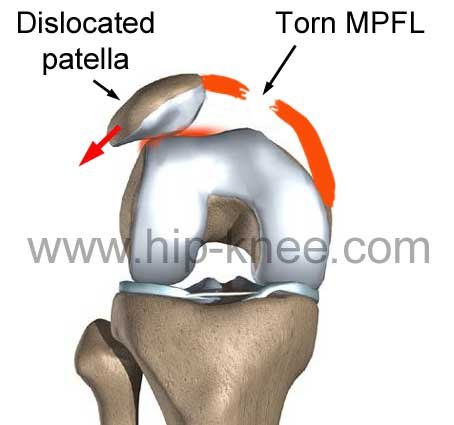Normally the patella glides in a groove in front of the thigh bone (femur). The patella may be dislocated from its normal position in front of the knee due to a sudden twisting injury of the knee or due to a direct trauma. In the vast majority of cases the patella dislocates toward the outer (lateral) aspect of the knee. The dislocation results in tearing of ligaments attaching the patella to the medial (inner) side of the thigh bone (femur). This is called the medial patellofemoral ligament (MPFL).
 Some factors may predispose to patellar dislocation including:
Some factors may predispose to patellar dislocation including:
- Generalized ligament laxity
- Shallow patellar groove on the femur
- Knocked knee (genu valgum) deformity
Symptoms:
There is sudden pain with apparent swelling and deformity of the knee. The patella is felt on the outer aspect of the knee joint and the patient is unable to stand on his leg.
Treatment:
First aid:
An attempt should be made to reduce the dislocated patella by straightening the knee and pushing the patella gently to its normal position.
Non-surgical treatment:
An X-ray and probably MRI are usually required, to ensure that no part of the bone or cartilage has been fractured during the dislocation. If such a fracture occurs, these loose fragments should be removed using an arthroscope to avoid causing more damage to the articular cartilage. The knee is then placed in a splint for a few weeks to allow the torn ligaments to heal.
The knee is then slowly mobilized with gradual strengthening of the muscles around the knee. Full recovery is usually expected after about 4-6 weeks.
Surgical treatment:
If the ligament holding the patella in its proper position does not heal satisfactorily, the patella may dislocated again and again with minor trauma. Recurrent patellar dislocation may cause damage to the knee cartilage leading to knee osteoarthritis. Thus, recurrent dislocation is better treated surgically, usually by reconstruction of the medial patellofemoral ligament (MPFL) that is responsible for preventing patellar dislocation. Also, an attempt should be done to treat any factor predisposing to dislocation e.g. knock knee deformity.

